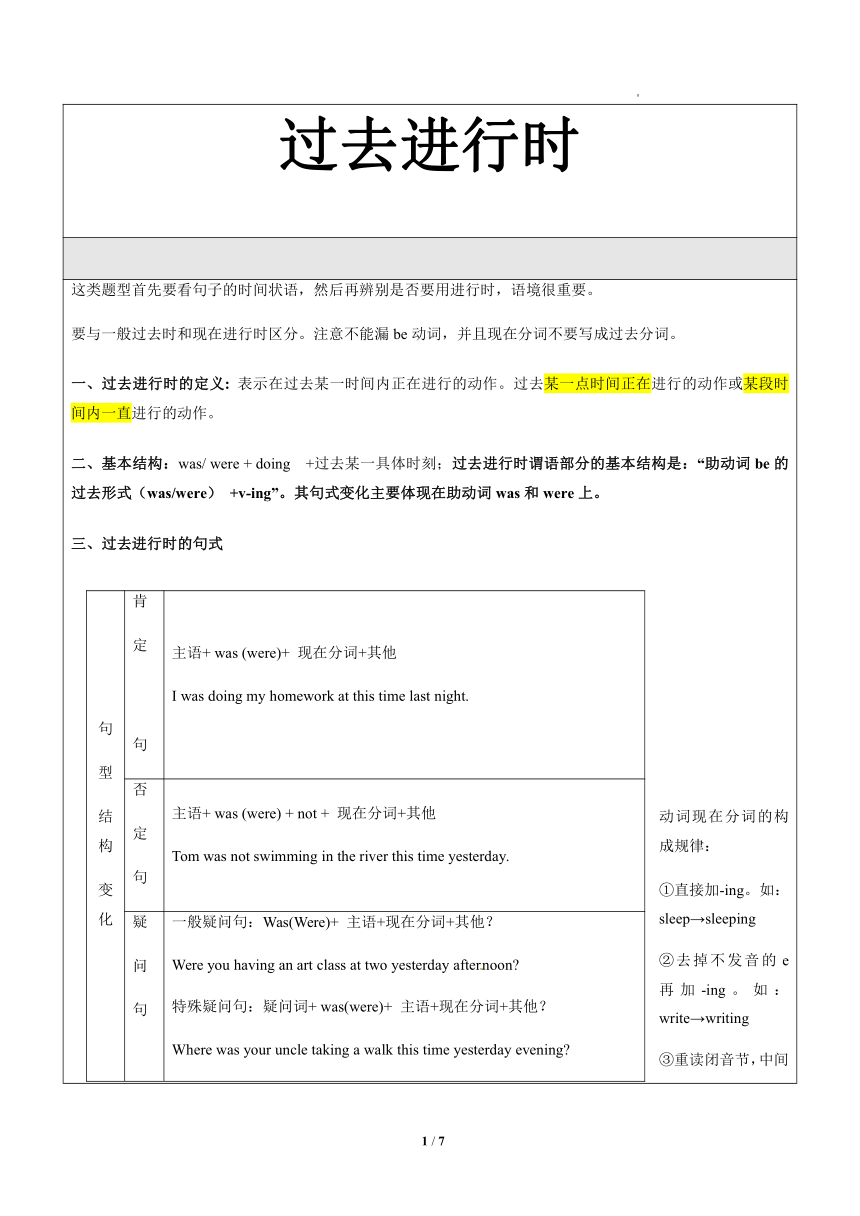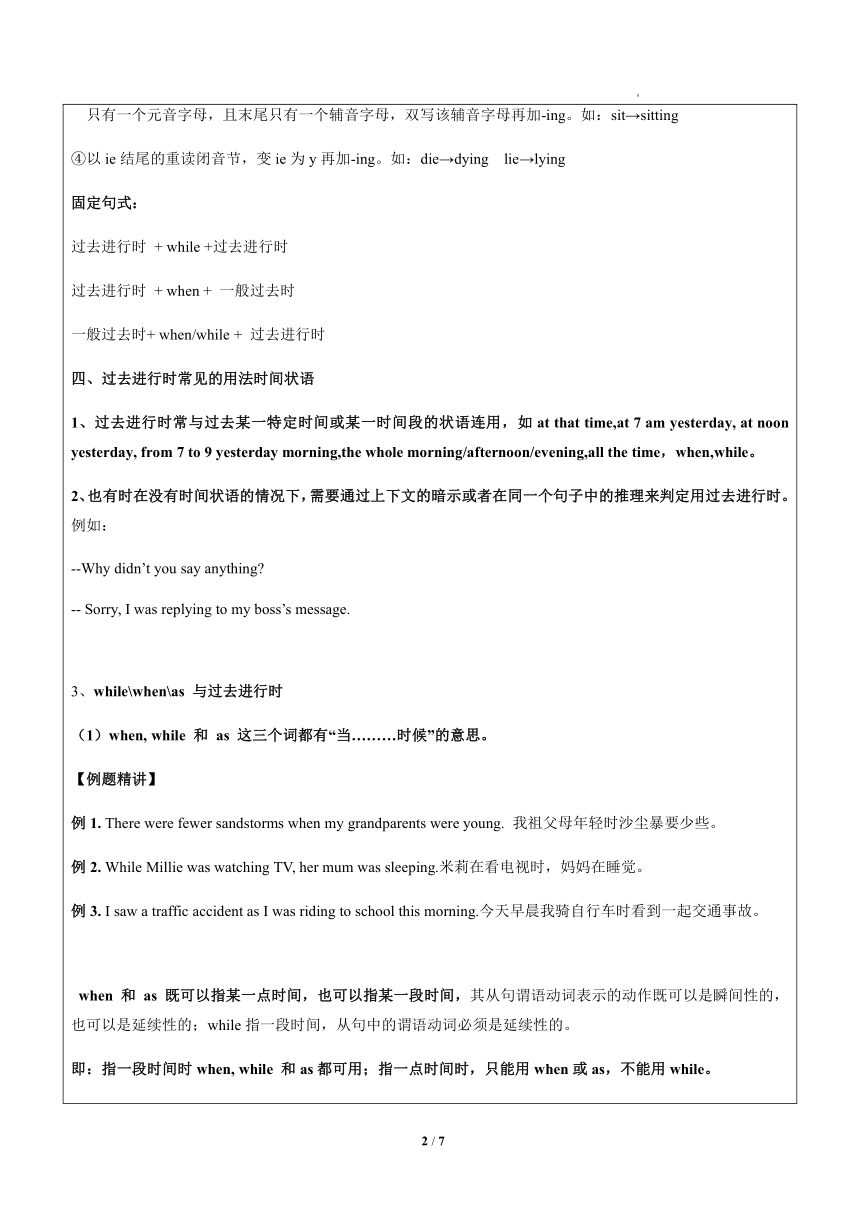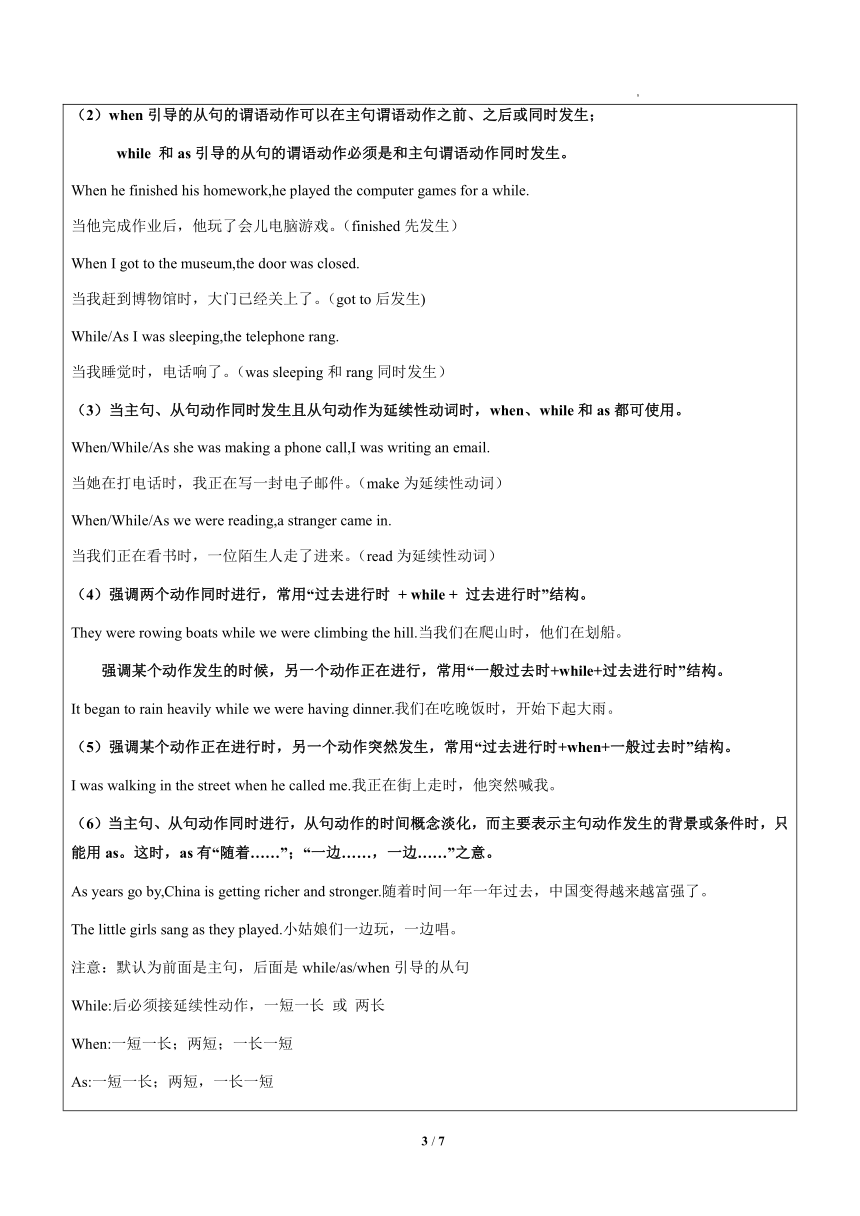 资源简介
资源简介
过去进行时
这类题型首先要看句子的时间状语,然后再辨别是否要用进行时,语境很重要。 要与一般过去时和现在进行时区分。注意不能漏be动词,并且现在分词不要写成过去分词。 一、过去进行时的定义: 表示在过去某一时间内正在进行的动作。过去某一点时间正在进行的动作或某段时间内一直进行的动作。 二、基本结构:was/ were + doing +过去某一具体时刻;过去进行时谓语部分的基本结构是:“助动词be的过去形式(was/were) +v-ing”。其句式变化主要体现在助动词was和were上。 三、过去进行时的句式 句 型 结构 变化肯 定[来.K] 句主语+ was (were)+ 现在分词+其他 I was doing my homework at this time last night.否 定 句主语+ was (were) + not + 现在分词+其他 Tom was not swimming in the river this time yesterday.疑 问 句一般疑问句:Was(Were)+ 主语+现在分词+其他? Were you having an art class at two yesterday afternoon 特殊疑问句:疑问词+ was(were)+ 主语+现在分词+其他? Where was your uncle taking a walk this time yesterday evening
动词现在分词的构成规律: ①直接加-ing。如:sleep→sleeping ②去掉不发音的e再加-ing。如:write→writing ③重读闭音节,中间只有一个元音字母,且末尾只有一个辅音字母,双写该辅音字母再加-ing。如:sit→sitting ④以ie结尾的重读闭音节,变ie为y再加-ing。如:die→dying lie→lying 固定句式: 过去进行时 + while +过去进行时 过去进行时 + when + 一般过去时 一般过去时+ when/while + 过去进行时 四、过去进行时常见的用法时间状语 1、过去进行时常与过去某一特定时间或某一时间段的状语连用,如at that time,at 7 am yesterday, at noon yesterday, from 7 to 9 yesterday morning,the whole morning/afternoon/evening,all the time,when,while。 2、也有时在没有时间状语的情况下,需要通过上下文的暗示或者在同一个句子中的推理来判定用过去进行时。例如: --Why didn’t you say anything -- Sorry, I was replying to my boss’s message. 3、while\when\as 与过去进行时 (1)when, while 和 as 这三个词都有“当………时候”的意思。 【例题精讲】 例1. There were fewer sandstorms when my grandparents were young. 我祖父母年轻时沙尘暴要少些。 例2. While Millie was watching TV, her mum was sleeping.米莉在看电视时,妈妈在睡觉。 例3. I saw a traffic accident as I was riding to school this morning.今天早晨我骑自行车时看到一起交通事故。 when 和 as 既可以指某一点时间,也可以指某一段时间,其从句谓语动词表示的动作既可以是瞬间性的,也可以是延续性的;while指一段时间,从句中的谓语动词必须是延续性的。 即:指一段时间时when, while 和as都可用;指一点时间时,只能用when或as,不能用while。 (2)when引导的从句的谓语动作可以在主句谓语动作之前、之后或同时发生; while 和as引导的从句的谓语动作必须是和主句谓语动作同时发生。 When he finished his homework,he played the computer games for a while. 当他完成作业后,他玩了会儿电脑游戏。(finished先发生) When I got to the museum,the door was closed. 当我赶到博物馆时,大门已经关上了。(got to后发生) While/As I was sleeping,the telephone rang. 当我睡觉时,电话响了。(was sleeping和rang同时发生) (3)当主句、从句动作同时发生且从句动作为延续性动词时,when、while和as都可使用。 When/While/As she was making a phone call,I was writing an email. 当她在打电话时,我正在写一封电子邮件。(make为延续性动词) When/While/As we were reading,a stranger came in. 当我们正在看书时,一位陌生人走了进来。(read为延续性动词) (4)强调两个动作同时进行,常用“过去进行时 + while + 过去进行时”结构。 They were rowing boats while we were climbing the hill.当我们在爬山时,他们在划船。 强调某个动作发生的时候,另一个动作正在进行,常用“一般过去时+while+过去进行时”结构。 It began to rain heavily while we were having dinner.我们在吃晚饭时,开始下起大雨。 (5)强调某个动作正在进行时,另一个动作突然发生,常用“过去进行时+when+一般过去时”结构。 I was walking in the street when he called me.我正在街上走时,他突然喊我。 (6)当主句、从句动作同时进行,从句动作的时间概念淡化,而主要表示主句动作发生的背景或条件时,只能用as。这时,as有“随着……”;“一边……,一边……”之意。 As years go by,China is getting richer and stronger.随着时间一年一年过去,中国变得越来越富强了。 The little girls sang as they played.小姑娘们一边玩,一边唱。 注意:默认为前面是主句,后面是while/as/when引导的从句 While:后必须接延续性动作,一短一长 或 两长 When:一短一长;两短;一长一短 As:一短一长;两短,一长一短 ★ 过去进行时用于when和while引导的时间状语从句中的区别 用when 引导的状语从句表示时间,说明一个动作发生的时候,另一个动作正在发生。 如: What were you doing when I came into the classroom 用when引导的状语从句也可表示在进行某一动作时另一个动作发生了。如: My wallet dropped on the ground when I was walking in the park. 用while 连接的状语从句一般用进行时,表示正在进行某一个动作时,发生了另一个动作,这时主句用一般过去时。while 和when的状语从句都可以表示正在进行某一个动作,但是while更强调动作持续一段时间。如: While we were boating on the lake, we saw a fish jump out of the water. While I was watching the basketball game, the ball flew over and hit me. 用while 连接的状语从句还可以表示某一个动作正在进行的同时,另一个动作也在进行中。如: While Dad was washing his car, Mum was cooking. ★过去进行时与现在进行时的区别 两种时态在句子的构成上的区别是:现在进行时态用am, is, are+现在分词(doing)形式。过去进行时态用was, were+现在分词(doing)形式。如: She is singing under the tree. 她正在树下唱歌。She was singing under the tree at that time. 她那个时候正在树下唱歌。 2. 两种时态在用法上的区别是:现在进行时态和过去进行时态虽然都用来表示动作正在进行。但是在表示说话时正在进行的动作时,要用现在进行时态。而在表示过去某个时段或过去某个时刻正在进行的动作时,就要用过去进行时态。如: She is planting a tree .她正在植树。(说话时正在植树) She was planting a tree at that time. (那时她在植树,此句指的是在过去那个时间里她正在植树)。 ★过去进行时与一般过去时的区别 过去进行时强调动作在过去某时刻正在进行或持续,而一般过去时表示动作的完成。如: He was writing his composition last night. 他昨晚在写作文。(不一定写完) He wrote his composition last night. 他昨晚写了一篇作文。(已经写完) 一般过去时与always, forever, 等连用,表示“过去经常性、习惯性的动作”;而过去进行时与always, forever等连用,表示动作的重复,常带有感彩。如: He always got up at six. 他过去总是六点起床。 He was always thinking of his work. 他总是一心想到工作。 中考链接: 1. He ____________(draw) on the beach from 7 to 9 o’clock yesterday morning. 2.The classroom had a power cut while we______________ (have) a physics lesson. 3.--Why didn’t you come to open the door for me --I _______(wash)dishes in the kitchen and didn’t hear the doorbell. 4.--Why didn’t you say anything -- Sorry, I_____ (reply) to my boss’s message. 5.--Why didn't you watch Running Man on TV --I________ (make) up the music for the coming School Art Festival. 6.---Tom, I didn’t see you at the party yesterday. ---I ___________________ (prepare) for my coming exam. 7.—I phoned you yesterday morning, but you were not in. —We (fish) by the river. 答案:1.was drawing 2.were having 3.was washing 4.was replying 5.was making6.was preparing 7.was fishing 五、做题时常见错误 1、丢掉be动词或忘记把动词变成现在分词。例如: (1)误:I watching (watch) TV when he came in. 正:I was watching (watch) TV when he came in. (2)误:They were play (play) games at 5:00 p.m. yesterday. 正:They were playing (play) games at 5:00 p.m. yesterday. 解析:过去进行时谓语部分的基本结构是:“助动词be的过去形式(was/were) +v-ing”。 2、对动词或动词词组提问时丢掉doing。例: We were flying kites at 5:00 p.m. yesterday. (对划线部分提问) 误:What were you at 5:00 p.m. yesterday 正:What were you doing at 5:00 p.m. yesterday 解析:对动词或动词词组提问时,一定要注意添上代动词do的现在分词形式。 3、易与现在进行时弄混。例如: 误:My mother is cooking (cook) when I got home. 正:My mother was cooking (cook) when I got home. 解析:这两种时态的共同点是都表示动作正在进行,但现在进行时前提是现在,而过去进行时前提是过去,由when I got home可看出前提是过去。 4、易与一般过去时弄混。例如: 昨晚我在读一本故事书。 误:I read a story book yesterday evening. 正:I was reading a story book yesterday evening. 解析:这两种时态的共同点是都用于表示过去发生的动作。但过去进行时强调动作正在进行,而一般过去时则表示过去某一时间所发生的动作或存在的状态,它表示的动作往往已经完成。“在”说明正在进行,而“I read a story book yesterday evening.”的意思是昨晚我读了一本故事书,言下之意已经读完了。故用过去进行时。 5.注意:英语中有五类动词一般不用进行时(不用现在进行时和过去进行时)。 1. 表心理状态、情感的动词 如love ,hate ,like ,care ,respect ,please ,prefer ,know 等,若用进行时则词意改变。 I’m forgetting it . (=beginning to forget ) 2. 表存在、状态的动词 如appear ,exist ,lie ,remain ,stand ,seem等。 3. 表感官的动词 如see ,hear ,feel ,smell ,sound ,taste等。 4. 表非延续性的动词 如accept ,allow ,admit ,decide ,end ,refuse ,permit ,promise等 表拥有的动词 如:have,own等
1
13 / 13
展开更多......
收起↑
 资源预览
资源预览



 资源预览
资源预览


